It was yet another hot and sunny day at Semakau, and I was also here just yesterday, bringing a group of students from Zhenghua Secondary for a guided walk. Today, however, was different. I would be doing seagrass monitoring work instead of doing a guided walk!
Ok, I was still arrowed to give an intro to the landfill at the jetty, but that's definitely different from doing a full guided walk :)
My buddy for the day was Helen, who was also a Semakau guide and a Wildfilm crew. We got the furthest seagrass site - Site 1. Walking to the site itself already took us quite a while, and thus I didn't really have much time to explore the intertidal area after we finish the monitoring work.
Been considering if I should post something on this trip, since I didn't really take many photos with the limited time for exploration, but finally decided to do it since this was my very first monitoring trip, and I must simply put it down some where :)
Yah, I've followed Siti and company on their monitoring trips before. But usually, I was tasked to do other things, such as helping with the filming, or guiding Dr Dan's group, so this was in fact the first time I'm doing the actual monitoring work.
Shufen was late (and thus so were the equipment), and she had to take another boat from West Coast Pier to get to Semakau. This was probably also partly why I got arrowed to do the long intro to Semakau Landfill while waiting for them. I enjoyed giving the intro though. It's always nice to share with others what you know about a place you like so much.
When we reached the intertidal area, we started with Len from Seagrass-Watch HQ (Australia) and Siti giving us a quick refresher on the types of seagrass while waiting for the equipment to arrive.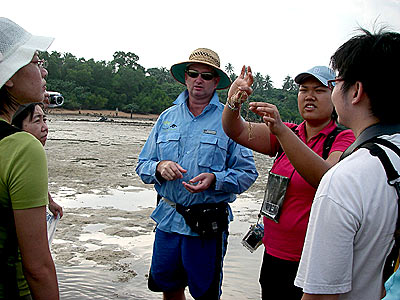
Len also gave a demo on how to do the monitoring properly. Helen and I then followed Shufen to walk all the way to the Wild Wild west of the seagrass lagoon to get to our monitoring site (it's located at the western end of the lagoon).
The photo below shows our transect tape in the fore ground, and the other two transect lines and the respective seagrassers in the background. Each monitoring site had 3 transect lines.
It so happened that there was a fairly big hard coral at the end of my transect line, which means in future if I do this line again, it will be quite easy for me to lay the transect tape since I know the ending point.
And below were the seagrassers at the other 2 monitoring sites.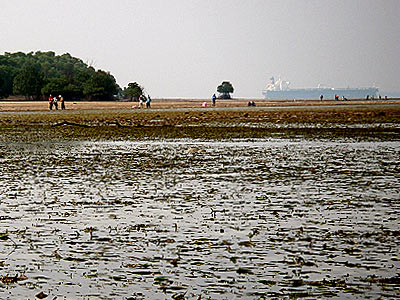
The whole process was quite interesting actually. The entire transect line was 50 metres, and we had to lay the transect square every 5 metres to note down the sediments, any special things found in the transect square, the seagrass percentage cover, the species percentage cover, the algae percentage cover, epiphytes percentage cover, and took a photo of the transect square at 5m, 25m and 45m. Here's one of the photo I took at 45m.
On the bottom left corner in the transect square, can you see a sand collar? This is the egg capsule of a moon snail (Family Naticidae). Since the sand collar is intact, it means the eggs are still alive. When they hatch, the collar disintegrates.
We found 4 species of seagrass along our transect line - Enhalus Acoroides, Halophila ovalis, Cymodocea serrulata and Halodule uninervis. Heh heh, hopefully my memory didn't fail me and these were indeed the species we have recorded.
The substrate was mostly sandy with a bit of mud and some broken shells here and there.
During the monitoring session, Helen and I had a bit problem figuring out the percentage cover for the seagrass and algae at some places, because we had assumed that since they occurred together, they should not add up to more than 100%. However, we were later enlightened by Len, who told us that it was even possible to have both 100% seagrass cover and 100% algae cover! This is because they may occur on different depth. For example, the seagrass may cover the entire sand surface, but the algae may be floating all around the place.
In any case, we finally managed to finish the monitoring, but tide was already rising and we only had very little time to explore the shores. We still had a few good finds though.
We found 2 upside-down jellyfish (Cassiopia sp.).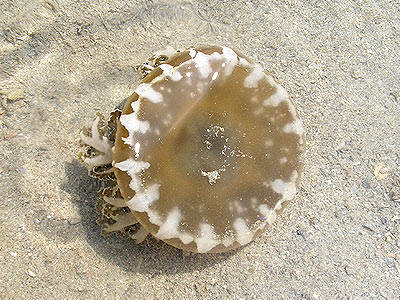
The photo below shows the jellyfish in the process of turning itself back to the upside-down position after we had turned it over for a quick photo shoot. In the end, we had to get it into shallow water so that it couldn't turn over so that we can get a few good shots. This jellyfish has symbiotic algae called zooxanthallae, mostly in its tentacles, which provides which photosynthesises better with it being upside-down. The jellyfish obtains energy from the food provided by the algae.
We also found this rock-boring giant clam (Tridacna crocea).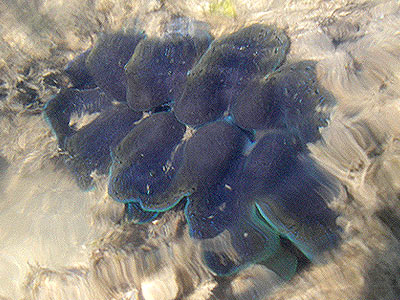
Like the upside-down jellyfish, giant clams also harbour zooxanthallae in its fleshy body, and have extensive digestive systems to extract the nutrients produced by the zooxanthellae.
And here's one of the anemone where we found a false clownfish (Amphiprion ocellaris). The anemone is probably a magnificent anemone (Heteractis magnifica) .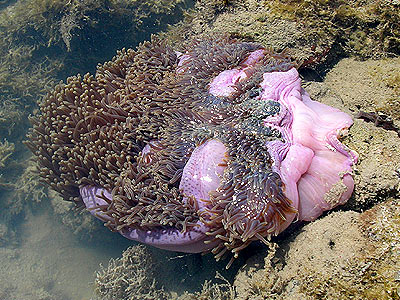
Kok Sheng was with me when we went nemo-seeking. I found two false clownfishes, one in the anemone above, and the other in a Merten's carpet anemone (Stichodactyla mertensii). However, on both counts, the nemo appeared when Kok Sheng was looking at the wrong place! By the time he tried to look for the nemo, it had gone back hiding in the anemone. Helen spotted the one at the magnificent anemone as well. I think Kok Sheng was quite suay that day that he missed both. Hahahahhaa....
But anyway, at least he finished his stuff earlier and had more time to explore the area, and thus he saw more things. Check out his blog for the details.
You can find out more about our seagrass trips at the Team Seagrass blog too!
Sunday, March 25, 2007
My First Seagrass Monitoring Trip
Subscribe to:
Post Comments (Atom)

2 comments:
haha, I heard fr him last time hes dying to see the anemone fish. Luck not with him.
Haha... anyway, there's always the next time :)
Actually, someone else (dunno his name) also spotted a tomato anemonefish. But when I heard about it, the tide was already too high for me to go way out to find it..
Post a Comment